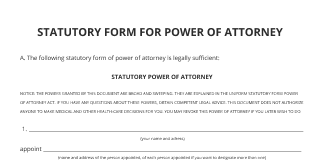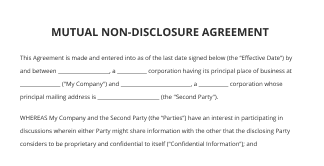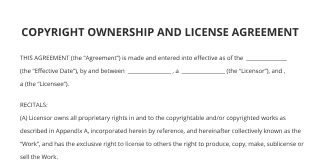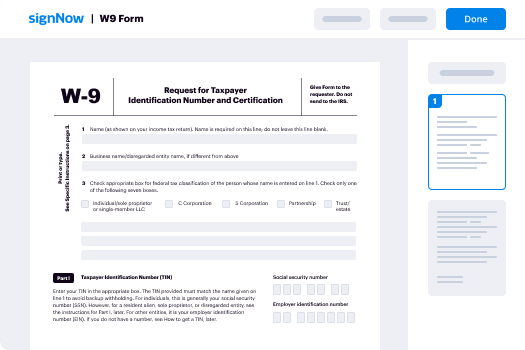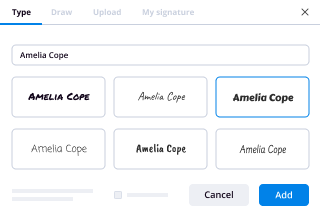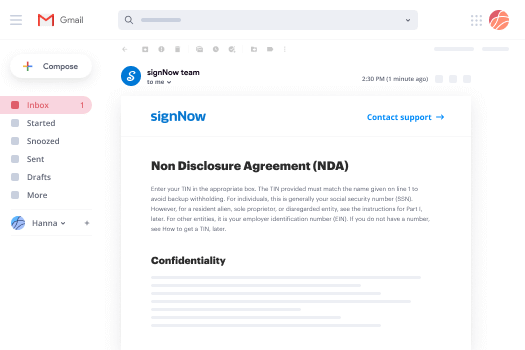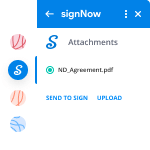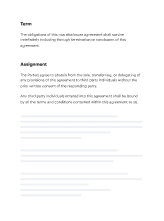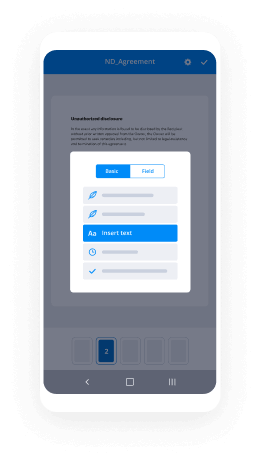Plantilla De Acuerdo De Indemnización Fácil De Usar
Obtén las potentes funciones de firma electrónica que necesitas de la solución en la que confías
Selecciona la plataforma profesional creada para profesionales
Configura rápidamente la API de firma electrónica
Mejora la colaboración juntos
Plantilla de acuerdo de indemnización en minutos
Reduce el tiempo de cierre
Mantén los datos importantes seguros
Vea las firmas electrónicas de airSlate SignNow en acción
Soluciones de airSlate SignNow para una mayor eficiencia
Las reseñas de nuestros usuarios hablan por sí mismas






Por qué elegir airSlate SignNow
-
Prueba gratuita de 7 días. Elige el plan que necesitas y pruébalo sin riesgos.
-
Precios honestos para planes completos. airSlate SignNow ofrece planes de suscripción sin cargos adicionales ni tarifas ocultas al renovar.
-
Seguridad de nivel empresarial. airSlate SignNow te ayuda a cumplir con los estándares de seguridad globales.

Tu guía paso a paso — mark severance agreement template
Aprovecha la firma electrónica de airSlate SignNow para que cualquier empresa pueda aumentar los flujos de firma y firmar electrónicamente en tiempo real, brindando una mejor experiencia a clientes y empleados. Usa la plantilla de acuerdo de indemnización en unos pocos pasos sencillos. Nuestras aplicaciones móviles hacen posible trabajar en movimiento, incluso sin conexión! Firma desde cualquier lugar del mundo y cierra tareas más rápido.
Cómo completar y firmar un mark severance agreement template
- Inicia sesión en tu cuenta de airSlate SignNow.
- Ubica tu documento en tus carpetas o importa uno nuevo.
- Abre la plantilla ajustándola desde la lista de Herramientas.
- Coloca campos rellenables, añade texto y firma electrónicamente.
- Incluye varios firmantes por correos electrónicos y establece el orden de firma.
- Elige qué destinatarios pueden recibir una versión firmada.
- Utiliza Opciones avanzadas para limitar el acceso al documento y establecer una fecha de expiración.
- Haz clic en Guardar y cerrar cuando termines.
Además, hay funciones más avanzadas disponibles para la plantilla de acuerdo de indemnización. Añade usuarios a tu entorno de trabajo compartido, visualiza equipos y realiza un seguimiento del trabajo en equipo. Millones de usuarios en EE. UU. y Europa concuerdan en que una solución que une a las personas en un único lugar digital cohesivo es exactamente lo que las organizaciones necesitan para mantener los flujos de trabajo sin problemas. La API REST de airSlate SignNow te permite integrar firmas electrónicas en tu aplicación, sitio web, CRM o almacenamiento en la nube. Descubre airSlate SignNow y obtén flujos de firma electrónica más rápidos, fáciles y productivos en general!
Cómo funciona
Funciones de airSlate SignNow que los usuarios adoran
Vea resultados excepcionales mark severance agreement template
¡Obtenga firmas legalmente vinculantes ahora!
Preguntas frecuentes mark severance agreement template
-
¿Cómo redacto un acuerdo de indemnización?
Detalles de compensación. Normas de confidencialidad tras la terminación. Fecha de terminación del empleado. Acuerdo de ambas partes en forma de firma. Detalles sobre cuánto tiempo el empleado continuará teniendo acceso a beneficios. -
¿Cuál es el paquete de indemnización típico?
La indemnización ofrecida suele ser de una a dos semanas por cada año trabajado, pero puede ser más. Si la pérdida del empleo crea una dificultad económica, discútelo con tu (ex) empleador. La práctica general es tratar de obtener cuatro semanas de indemnización por cada año trabajado. -
¿Se puede solicitar indemnización si renuncias?
Renunciar te deja con muy pocas opciones. No tendrás sueldo mientras buscas un nuevo trabajo. Tu empleador no te dará indemnización y generalmente no serás elegible para la compensación por desempleo. ... Has decidido que dejar a tu empleador actual renunciando a tu trabajo es la respuesta. -
¿Puedo demandar si firmé un acuerdo de indemnización?
Si tu acuerdo de indemnización incluía una liberación, es posible que hayas renunciado a tu derecho a demandar a tu antiguo empleador. Algunos empleadores ofrecen indemnización a los empleados que pierden sus trabajos. Sin embargo, a menudo, los empleados que desean un paquete de indemnización deben firmar una liberación o renuncia, mediante la cual renuncian a su derecho a demandar a la empresa. -
¿Debo aceptar la indemnización?
¿Tienes que aceptar un paquete de indemnización? La respuesta corta es no. No tienes que aceptar lo que tu empleador ofrece, ni firmar una liberación. Una liberación solo es válida si es voluntaria: si tu empleador te obliga o coacciona a firmar, no será respaldada en la corte. -
¿Qué es una carta de indemnización?
Un paquete de indemnización es pago y beneficios a los empleados que pueden recibir cuando dejan la empresa de manera no voluntaria. ... Además de su salario regular restante, puede incluir algunos de los siguientes: Cualquier pago adicional basado en meses de servicio. -
¿Puedo demandar después de firmar un acuerdo de indemnización?
Si tu acuerdo de indemnización incluía una liberación, es posible que hayas renunciado a tu derecho a demandar a tu antiguo empleador. Algunos empleadores ofrecen indemnización a los empleados que pierden sus trabajos. Sin embargo, a menudo, los empleados que desean un paquete de indemnización deben firmar una liberación o renuncia, mediante la cual renuncian a su derecho a demandar a la empresa. -
¿Qué pasa si no firmas un acuerdo de separación?
Aunque no tienes que firmar un acuerdo de indemnización, tu empleador puede hacer que sea una condición para recibir la indemnización. ... Sin embargo, en la mayoría de los casos, un empleador puede condicionar la indemnización a que el empleado firme el acuerdo. En otras palabras, si el empleado se niega a firmar, no recibirá ninguna indemnización. -
¿Qué es un acuerdo de separación confidencial?
Para hacer esto, la mayoría de las empresas utilizan un acuerdo de separación laboral. ... Los acuerdos de separación laboral no son requeridos por ley; las empresas los usan para sellar información confidencial de la empresa o para protegerse de demandas. Después de firmar, un empleado no puede demandar a los empleadores por despido injustificado o pago de indemnización. -
¿Se puede firmar un acuerdo de separación sin un abogado?
La ley no requiere que una persona tenga un abogado para crear un acuerdo de separación. Algunos cónyuges, citando gastos, consideran crear su propio acuerdo de separación sin un abogado. ... Los acuerdos de separación pueden ser bastante complejos, como puedes imaginar. -
¿Qué pasa después de que se firma un acuerdo de separación?
Haciendo cumplir un acuerdo de separación Una vez que tú y tu cónyuge han firmado el acuerdo, se convierte en un contrato legalmente vinculante que ambos deben cumplir. Esto significa que puedes demandar a tu cónyuge o ex cónyuge por daños si incumplen el acuerdo y para hacer cumplir sus términos. -
¿Debería firmar un acuerdo de separación y liberación?
Aunque no tienes que firmar un acuerdo de indemnización, tu empleador puede hacer que sea una condición para recibir la indemnización. ... Sin embargo, en la mayoría de los casos, un empleador puede condicionar la indemnización a que el empleado firme el acuerdo. En otras palabras, si el empleado se niega a firmar, no recibirá ninguna indemnización.
Lo que dicen los usuarios activos — mark severance agreement template
Búsquedas relacionadas con mark severance agreement template
Mark severance agreement template
inside America's boardrooms the informational show for board members and corporate secretaries brought to you with knowledge partners villager's PwC Center for audit quality Spencer steward The Conference Board and corporate board members along with content contributors equal our Veridian compensation partners Wilson Sonsini Goodrich Androzani Donnelly financial solutions and the Society for corporate governance welcome to this edition of inside America's boardrooms I'm TK curse that are the CEO of boardroom resources and the co-founder and editor large of corporate board member it's my pleasure to welcome you to the show we're filming here today in the New York studios of The Conference Board and our topic today is how to structure a fair executive severance arrangement and my guest is someone who is versed in this topic and is going to help the audience understand that what to know and welcome Ryan Harvey who's a partner with Meridian compensation Partners welcome Ryan thanks TK we're gonna start very Elementary okay and I think everybody knows the answers to this but we're still gonna ask the question and that is sort of why a severance is part of the package and why it's important to the board yep yep well very often in at least in the press executive confident our executive severance arrangements can be construed as being paid for failure and there's definitely examples out there of severance arrangements which are paid for failure that kind of reinforced that stereotype but I think if they're if they're well constructed they can really support the the needs of shareholders and also can remove a lot of headaches for the board a couple of quick things I would point out that our kind of benefits of having severance of pre-established one of those is it removes the ad hoc negotiation that often goes on when you don't have severance in place so many companies that don't put severance they still they still end up providing severance to executives who terminate but then they have to rely on kind of negotiations at that they allowed and you just don't know what circumstances are gonna be present when you terminate somebody there's very often kind of adverse business conditions there can be emotions that get involved and and very often the company is trying to get the executive to agree to different things like a non-disparagement or non-compete so waiting to the eleventh hour can put you in a weird position I seen many boards where they feel pressured to make decisions that they maybe wouldn't make if they could have designed severance kind of in the light of day before they actually got to a termination so so having that in place I think can be very helpful another thing is it just adds to inconsistency if you don't have pre-established severance so if your ad hoc going out and negotiating on a case-by-case basis you can have very different severance practices between executives over time which is something you want to avoid but probably the biggest thing to mention is just it's a competitive practice over two-thirds of companies in the US now provide executive severance to their senior executives so it's it's starting to become really a standard part of a competitive package particularly if you're trying to recruit an executive externally it could be really the final piece that gets that executive comfortable with making decision to make the move yeah and that history goes way back I mean this is not severance is not anything new it's been part of the process the question is how do you get it right in a non-emotional you know so you know we sort of established that in the end it's a good thing for shareholders Arthur when somebody looks at say-on-pay which this may be a part of what are they what are the like the key design things that people are looking for that sort of make it fair sure there's a couple of different things you want to look at if you're trying to design a really a fair severance arrangement both for executives and for shareholders the key thing when you're designing severance is you want to really provide enough value to bridge that executive to the next employer and at the executive level it could take a year maybe more than a year to find a comparable job at a new employer particularly if you have a non-compete provision that's preventing you from going to a direct competitor so because of that we generally see somewhere between one to one-and-a-half times the annual cash compensation is kind of the standard severance multiple for senior executives and annual compensation is generally includes both base salary and target target annual bonus at the CEO level it's often a little bit higher than that maybe two times is not unusual but again one and a half one to one and a half is it pretty typical and generally enough to bridge them to the next employer you also will generally see the continued continuation of health and welfare benefits for the same period as you're providing severance on the company side committees really need to step back and think about what kind of restrictions they might want to place on the executive post termination pretty universally severance arrangements have a waiver of legal claims but beyond that I would generally recommend companies take a look at at least adding a non-disparagement restriction a non solicitation of employees and a non solicitation of customers and those are those three restrictions are generally enforceable across the US and they just make a lot of sense of and you don't want a disgruntled executive out there on social media disparaging the company you don't want them to be able to poach Talent and you also don't want them to steal customers so those three I think are pretty pretty solid and should really be included in really any severance arrangement the one that you really have to think a little bit more about is the non-compete they are very common so 70 percent of severance arrangements have non-compete clauses although a non-compete is not enforceable in every jurisdiction so you really have to work with legal counsel to think through whether it makes sense or not but if it is enforceable it could be a very useful tool to avoid having an exec you've got and directly compete with you post termination as you mentioned in the air answer the first question the shareholders can sometimes get have the hair of their necks stand up when they see big payouts to CEOs who have really sort of destroyed shareholder value and that's always tough to take on that so what are when we think about a compensation committee from your experience what are the biggest mistakes maybe that a that a compensation committee might make and it's negotiating this severance as part of the package bringing an executive in knowing that if you don't do it at all that's the biggest mistake sure sure there's probably two mistakes that are the biggest or the ones that can get you in the headlines one would be improperly defining the triggers of what's going to trigger severance and the other would be being overly generous with long-term incentive treatment so on the trigger side you know most severance arranged in fact almost all severance arrangements will only trigger severance well the only way you cannot trigger severance is to terminate the executive for cause so and causes is generally very narrowly defined in most executive severance arrangements you essentially have to have you know gross negligence on the part of the executive typically commission of a crime conviction of a felony for example or fraud so it's very narrow and not many companies ever exercise clause because of that but we would really recommend that the companies step back and take a look at that cause definition make sure that it's broad enough you can you can terminate the executive for you know the areas where the committee really believes they should have the ability to terminate without triggering severance so for example you know sexual harassment you should be able to terminate an executive for sexual harassment issues for violation of company's code of conduct or ethical issues so really kind of diving deep there I think is important we do see a minority of companies that go further and and incorporate performance related clauses it's not common and it is a bit of a slippery slope that you have to be careful because you could essentially define almost every involuntary termination as a termination for performance but but I think it is valuable to take a look at that and I think for some committees it might make sense particularly if committee is very reluctant to a severance plan in place because they were worried about maybe providing severance to a poor performer this can provide them with you know some discretion around when they implement it but still have the structure and the consistency of having a severance plan in place the other the other area where we see kind of the headlines very often is on treatment of long-term incentives and you know when you see these big headlines where an executive is walking away with tens of millions of dollars of value what's usually driving that value is not the cash severance it's usually because they were they were very very generous with the equity treatment and the long term incentive treatment and so I would I generally would recommend do not fully vest long term incentives and five and we kind of fully pay out long term incentives at the time of termination those are meant to cover multiple years of service by the executive if you pay them all out at termination it's more than likely gonna be an excessive amount of value so generally some sort of proration is probably the right answer although many companies actually forfeit LTI is not uncommon but I think probably the fairest treatment is some sort of proration based on the the performance that the executive is actually provided with the company and if it is performance based the the fairest treatment is likely to wait until the end of the performance period and actually base the proration on actual performance so you do have to wait a bit if you do that but it is I think it's fair to these executive and fair to the company to do it that way I would imagine that any investigative reporter though even if something spread out as doing their own math and adding up if they can then find that information but I agree with you I think that's a that's a wise plan because if if not you know it's it's nice to keep the headlines a reasonable sure sure for that so well Ryan this is there's some great advice in this I want to thank you for taking the time to join us today and we're really covered quite a specific topic we're just looking at the severance but hopefully over time we'll try and pick apart all the issues that a comp committee has to deal with but this is certainly one and an important one so I want to thank you for taking the time great thanks for having me and that will conclude this edition of inside America's boardrooms we hope you enjoyed the show we'll be back again next week when we take another look at a critical topic that will help you be a better board member or committee member silicium join us again next week for inside America's boardroom brought to you with knowledge partners diligent PwC Center for audit quality Spencer Stewart the conference pool and corporate board members along with content contributors equilon with Ian compensation partners Wilson Sonsini good Rajendra's aunty Donnelly to Metro solutions and the Society for corporate governance [Music]
Show more




